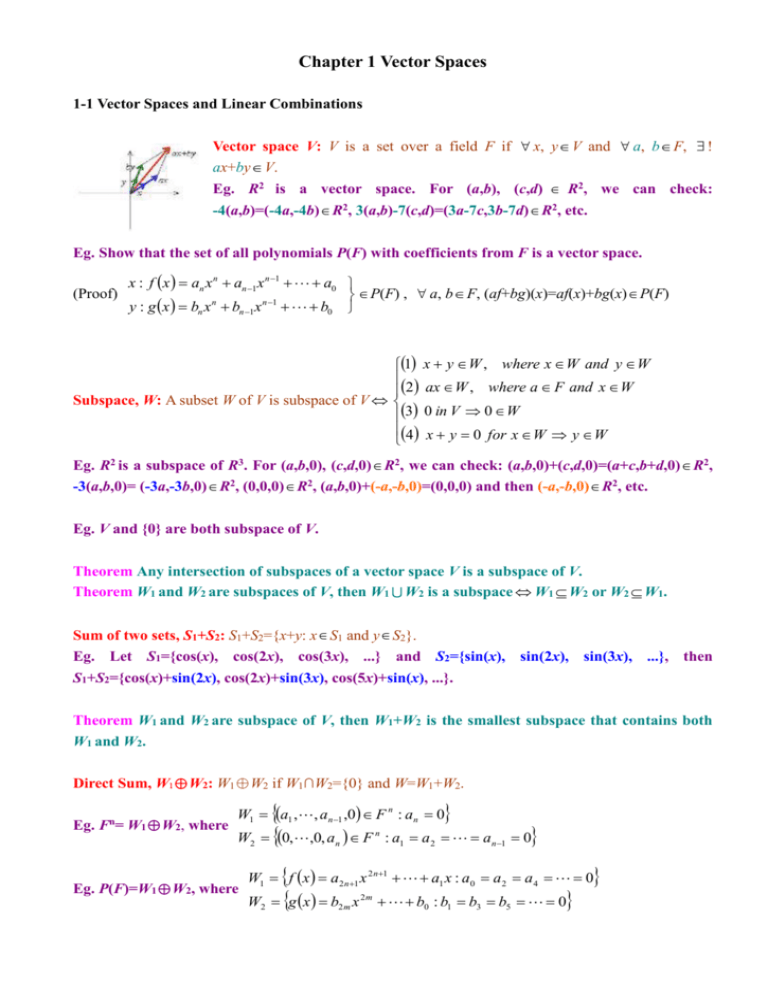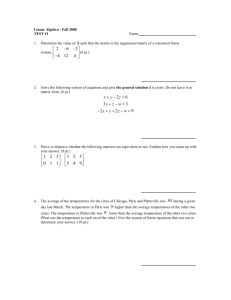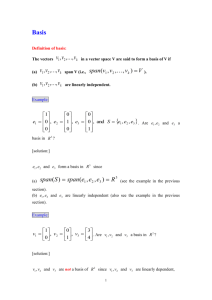Chapter 1 Vector
advertisement

Chapter 1 Vector Spaces
1-1 Vector Spaces and Linear Combinations
Vector space V: V is a set over a field F if x, y V and a, b F, !
ax+by V.
Eg. R2 is a vector space. For (a,b), (c,d) R2, we can check:
-4(a,b)=(-4a,-4b) R2, 3(a,b)-7(c,d)=(3a-7c,3b-7d) R2, etc.
Eg. Show that the set of all polynomials P(F) with coefficients from F is a vector space.
x : f x an x n an 1 x n 1 a0
(Proof)
P(F) , a, b F, (af+bg)(x)=af(x)+bg(x) P(F)
y : g x bn x n bn 1 x n 1 b0
1 x y W , where x W and y W
2 ax W , where a F and x W
Subspace, W: A subset W of V is subspace of V
3 0 in V 0 W
4 x y 0 for x W y W
Eg. R2 is a subspace of R3. For (a,b,0), (c,d,0) R2, we can check: (a,b,0)+(c,d,0)=(a+c,b+d,0) R2,
-3(a,b,0)= (-3a,-3b,0) R2, (0,0,0) R2, (a,b,0)+(-a,-b,0)=(0,0,0) and then (-a,-b,0) R2, etc.
Eg. V and {0} are both subspace of V.
Theorem Any intersection of subspaces of a vector space V is a subspace of V.
Theorem W1 and W2 are subspaces of V, then W1∪W2 is a subspace W1 W2 or W2 W1.
Sum of two sets, S1+S2: S1+S2={x+y: x S1 and y S2}.
Eg. Let S1={cos(x), cos(2x), cos(3x), ...} and S2={sin(x), sin(2x), sin(3x), ...}, then
S1+S2={cos(x)+sin(2x), cos(2x)+sin(3x), cos(5x)+sin(x), ...}.
Theorem W1 and W2 are subspace of V, then W1+W2 is the smallest subspace that contains both
W1 and W2.
Direct Sum, W1⊕W2: W1⊕W2 if W1∩W2={0} and W=W1+W2.
Eg. Fn= W1⊕W2, where
0,,0, a F
W1 a1 ,, a n1 ,0 F n : a n 0
W2
Eg. P(F)=W1⊕W2, where
n
g x b
n
: a1 a 2 a n1 0
W1 f x a2 n1 x 2 n1 a1 x : a0 a2 a4 0
W2
2m
x 2 m b0 : b1 b3 b5 0
Even function: f(-x)=f(x), Odd function: f(-x)=-f(x)
Eg. x2, x2-7x10, cos(x) are even functions, but x, 3x-2x3 +5x7, sin(4x) are odd functions.
Theorem W1 and W2 are the set of all even functions and the set of all odd functions in F(C,C),
respectively. Then F(C,C)=W1⊕W2.
(Proof)
1. W1, W2 are both subspaces of F(C,C)
2. f(x) W1 ∩W2, f(x)=f(-x)=-f(x) f(x)=0, ∴ W1 ∩W2={0}
1
h( x) 2 g ( x) g ( x)
Let
, then h(x) W1 , i(x) W2, ∴ F(C,C)=W1⊕W2.
1
i( x) g ( x) g ( x)
2
Theorem Let W1 and W2 be two subspaces of a vector space V over F, and then
V=W1⊕W2 x V, ! x1 W1 , ! x2 W2 such that x=x1+x2.
x
y1
x2
W2 , x1-y1=y2-x2
y2
(Proof) Suppose x=x1+x2=y1+y2, 1 W1 ,
∵ x1-y1 W1, y2-x2 W2, ∴ x1-y1=y2-x2 W1 ∩W2={0} x1=y1, x2=y2.
Eg. Let W1, W2, and W3 denote the x-, the y-, and the z-axis, respectively. Then R3= W1⊕W2⊕W3,
Wi∩ ( W j ) ={0}. (a,b,c) R3, (a,b,c)=(a,0,0)+(0,b,0)+(0,0,c), where (a,0,0) W1, (0,b,0) W2,
j i
(0,0,c) W3. ∴ R3 is uniquely represented as a direct sum of W1, W2, and W3.
Eg. Let W1 and W2 denote the xy- and the yz-planes, respectively. Then R3=W1+W2 and
W1∩W2={(x,y,z)∣x=z=0}≠{0}. (a,b,c) R3, (a,b,c)=(a,0,0)+(0,b,c)=(a,b,0)+(0,0,c), where (a,0,0),
(a,b,0) W1 and (0,b,c), (0,0,c) W2, ∴ R3 can not be uniquely represented as a direct sum of W1
and W2.
Theorem W is a subspace of V and x1, x2, x3, …, xn are elements of W, then
n
a x
i 1
i
i
is an element
of W for any ai over F.
(Proof) n=2, it holds by definition. Suppose n=k (k 2),
ik
a x
i 1
i k 1
ik
i 1
i 1
i
i
is an element of W, and then n=k+1,
ai xi ak 1 xk 1 ( ai xi ) is also an element of W by definition. ∴ the proof is complete.
Linear combination, y=a1x1+a2x2+…+anxn: It is called the linear combination of x1, x2, …, xn in V,
where ai F, i n, x S and S is a nonempty subset of V.
Span(S) (the subspace generated by the elements of S): The subspace consists of all linear
combinations of elements of S.
Eg. S={x.y}, then Span(S)={ax+by: a, b F}={3x-2y, -6x+1.5y, 4.3x+7.45y, 2x, -7y, …}.
Theorem (a) S is a nonempty subset of V Span(S) is a subspace of V. (b) Span(S) is the smallest
subspace of V containing S in the sense that Span(S) is a subset of only subspace of V that
contains S.
a b 1 0 0 1 0 0
0 0
Eg. ∵ a, b, c, d F,
= a
+ b
+ c
+d
,
0 1
c d 0 0 0 0 1 0
1 0 0 1 0 0 0 0
,
,
,
).
∴ M2×2(R)=Span(
0
0
0
0
1
0
0
1
Eg. ∵ (a,b,c)=a(1,0,0)+b(0,1,0)+c(0,0,1)=
abc
acb
bca
(1,1,0)+
(1,0,1)+
(0,1,1) a, b,
2
2
2
c F, ∴ R3=Span({(1,0,0),(0,1,0),(0,0,1)})=Span({(1,1,0),(1,0,1),(0,1,1)}).
1
0
Eg. Plot Span( )∪Span( ). [2006 台科大電子所]
1
1
1
1
0
0
1
0
(Sol.) Span( )=a : a line of x=y, Span( )=b : the y-axis. Span( )∪Span( ): a union of
1
1
1
1
1
1
1
0
1
0 a
x=y and the y-axis. Note: Span( )∪Span( )≠Span( )+Span( )=
is the xy-plane.
1
1
1
1 a b
Eg. Let S={x1,x2, …,xn} be linearly independent set and their coefficients be selected from {0,1}.
How many elements are there in Span(S)?
0
(Sol.) If y Span(S), y=a1x1+a2x2+…+anxn, ai , ∴ 2n elements.
1
Theorem Span(φ)={0}.
Theorem A subset W of a vector space V is a subspace of V Span(W)=W.
(Proof) "" : ∵ Span(W) is a subspace of V, ∴ W= Span(W) is a subspace of V.
"" : If Span(W)=W’≠W, W’ is a subspace of V.
∵ W’= Span(W) is the smallest subspace of V containing W, ∴ W is a not subspace of V.
It is contradictory to the statement. ∴ Span(W)=W’=W.
Theorem (a) If S1 and S2 are subspace of V and S1 S2, then Span(S1) Span(S2).
(b) Span (S1∩S2) Span(S1)∩Span(S2). [台大電研]
(Proof) (a) y= a1 x1 a2 x2 an xn Span( S1 ) , ai F and xi S1
S1 S 2 , xi S 2 y Span( S 2 ), Span( S1 ) Span( S 2 )
(b) S1 S 2 S1 , Span( S1 S 2 ) Span( S1 ) (1)
and S1 S 2 S 2 , Span( S1 S 2 ) Span( S 2 ) (2)
by (1), (2) Span( S1 S 2 ) Span( S1 ) Span( S 2 )
Theorem If S1 and S2 are subspace of V, then Span(S1∪S2)=Span(S1)+Span(S2). [台大電研]
Span( S1 )
S
(Proof) ∵ 1 S1 S 2 , ∴
SpanS1 S 2
Span( S 2 )
S 2
Suppose Span(S1∪S2)=Span(S1)+Span(S2)+W, where W is independent of S1 and S2, and
W V ( S1 , S 2 V ) . Let S1=S2 W , ∴ Span(S1∪S2)= Span(S1)+ Span(S2)
1-2 Linear Dependence and Linear Independence
Linear dependence & linear independence: For x1, x2, …, xn S,
n
a x
i 1
i
i
=0 if a1, a2, …, an are all
zeros, then S is linearly independent; otherwise, S is linearly dependent.
Eg. (3,2) and (-6,-4) are linearly dependent because of 2(3,2)+1(-6,-4)=0,
but (1,2) and (3,2) are linearly independent because of only
0(1,2)+0(3,2)=0
Theorem V is a vector space, S1 S2 V.
(a) If S1 is linearly dependent, then S2 is also linearly dependent.
(b) If S2 is linearly independent, then S1 is also linearly independent.
Basis: A basis β for a vector space V is a linearly independent subset of V that generates V.
Dimension, dim(V): The unique number of elements in each basis for V.
Theorem If V=W1⊕W2, then dim(V)=dim(W1)+dim(W2).
a
a 1 0
1 0
Eg. R2, we have =a +b . Thus { , } is the basis of R2 and dim(R2)=2.
b
b 0 1
0 1
a
a 1 0 0
1 0 0
Eg. b R3, we have b =a 0 +b 1 +c 0 . Thus { 0 , 1 , 0 } is the basis of R3 and
c
c 0 0 1
0 0 1
dim(R3)=3.
Eg. For W={(a1,a2,a3,a4,a5) R5: a1+a3+a5=0, a2=a4}, find a basis of W and dim(W).
(Sol.) a1+a3+a5=0. Set a1=r, a3=s, a5=-r-s, and set a2=a4=t.
(a1,a2,a3,a4,a5)=(r,t,s,t,-r-s)=r(1,0,0,0,-1)+t(0,1,0,1,0)+s(0,0,1,0,-1)
Basis of W: {(1,0,0,0,-1),(0,1,0,1,0),(0,0,1,0,-1)} and dim(W)=3.
1 0
1 0
1 0
1 0
Eg. Let V=Span{A1,A2,A3,A4}, where A1= 0 1 , A2= 0 1 , A3= 0 1 , and A4= 0 1 . Find a
1 1
1 1
0 1
1 0
basis for V. [2005台大電研]
ar
0
a b c d
0 0
= 0 0 b r
(Sol.) aA1+bA2+cA3+dA4=
0
a
b
c
d
c 2r
a b d
a b c 0 0
d 0
∴ A1, A2, A3, and A4 are linearly dependent. In fact, 0.5A1+0.5A2=A3.
We can drop A3,
a'b'c' 0 0 0
a ' 0
a'A1+b’A2+c’A4=
=
, ∴ A1, A2, and A4 are linearly independent.
0 a'b'c' 0 0 b' 0
c' 0
a'b'c' a'b' 0 0
∴ {A1,A2,A4} is the basis of V.
Theorem β={x1,x2, …,xn} is a basis for V y V can be uniquely expressed as a linear
combination of vectors in β.
(Proof) If y= a1 x1 an xn b1 x1 bn xn , 0= (a1 b1 ) x1 (an bn ) xn
∵ β is linearly independent, ∴ a1 b1 an bn 0 a1 b1 ,, an bn
Theorem S is a linearly independent subset of V, and let x V but x S. Then S∪{x} is linearly
dependent x Span(S).
Eg. Show that in case β={x1,x2,x3} be a basis in R3, then β’={x1,x1+x2, x1+x2+x3} is also a basis in
R3. [文化電機轉學考]
(Proof) Set a1 x1 a2 ( x1 x2 ) a3 ( x1 x2 x3 ) 0 … (1). If a1 a2 a3 0 , then x1, x1+x2,
x1+x2+x3 are linearly independent
(1) (a1 a2 a3 ) x1 (a2 a3 ) x2 a3 x3 0 …(2)
a1 a2 a3 0
a1 0
a2 0 , ∴ x1, x1+x2, x1+x2+x3 are linearly independent.
a2 a3 0
a 0
a 0
3
3
∵ dim(R3)=3, ∴ β’ is a basis of R3.
x1
1 0
Another method: x1 x2 1 1
x1 x2 x3 1 1
of R3.
0 x1
1 0
0 x2 , det( 1 1
1 1
1 x3
0
0 ) =1≠0, ∴ β’ is also a basis
1
Eg. Determine whether the given set of vectors is linearly independent? [交大電信所]
(a) {(1,0,0),(1,1,0),(1,1,1)} in R3.
(b) {(1,-2,1),(3,-5,2),(2,-3,6),(1,2,1)} in R3.
(c) {(1,-3,2),(2,-5,3),(4,0,1)} in R3.
1 1 1
(Sol.) (a) det( 0 1 1 ) =1≠0, ∴ Linearly independent. (b) 4 vectors in R3, ∴ Linearly dependent.
0 0 1
2 4
1
(c) det( 3 5 0) 5 36 40 6 5 0 , ∴ Linearly independent.
2
3 1
Eg. Are (x-1)(x-2) and |x-1|.(x-2) linearly independent? [1990 中央土木所]
(Sol.) 1. If 1<x, c1 ( x 1)( x 2) c2 x 1 ( x 2) c1 ( x 1)( x 2) c2 ( x 1)( x 2) 0 c1 c2
2. If x<1, c1 ( x 1)( x 2) c2 x 1 ( x 2) c1 ( x 1)( x 2) c2 ( x 1)( x 2) 0 c1 c2
(1), (2) hold c1=c2=0, ∴ Linearly independent.
5 3
1 1 0 0 0 2 0 1
Eg. Given a matrix A=
and a set of matrices S={
,
,
}.
,
1 2
1 0 1 1 0 1 1 0
Determine if S is a linearly independent subset of M2×2, the vector space of all 2×2 matrices?
Represent the matrix A as a linear combination of the vectors in the set S. What are the
corresponding coefficients? [台大電研]
a0
2c d 0
1 1 0 0 0 2 0 1 0 0
(Sol.) Let a
+b
+c
+d
=
a=b=c=d=0
b
d
0
1 0 1 1 0 1 1 0 0 0
b c 0
1 1 0 0 0 2 0 1
∴ S={
,
,
} is a linearly independent subset of M2×2.
,
1 0 1 1 0 1 1 0
e5
e5
f 2
5 3
1 1 0 0 0 2 0 1
e 2 g h 3
Let
=
e
+f
+g
+h
1 2
1 0 1 1 0 1 1 0
e f h 1
g 0
f g 2
h 2
Eg. W1 and W2 are finite-dimensional subspace of V, and dim(W1)=m, dim(W2)=n (m n), then
dim(W1∩W2)≦n and dim(W1+W2) m+n. [2010 台大電研]
(Proof) 1. W1∩W2 W2, ∴ dim(W1∩W2)≦dim(W2)=n
2. dim(W1+W2)=dim(W1)+dim(W2)-dim(W1∩W2), ∵ dim(W1∩W2)≧0, ∴ dim(W1+W2) m+n
Eg. Let v be the span of the set of vectors S={(1,-1,3),(0,2,1),(1,3,5)}.(a) What is the dimension of ν?
(b) Can we use S as a basis of v? [2006台科大電研]
(Sol.) (a) Let a(1,-1,3)+b(0,2,1)+c(1,3,5)=(0,0,0) a=-1, b=-2, c=1, ∴ S={(1,-1,3),(0,2,1),(1,3,5)} is
linearly dependent. ∵ S’={(0,2,1),(1,3,5)} is linearly independent, ∴ dim(v)=2.
(b) No!
Transpose of a m×n matrix M, Mt: An n×m matrix Mt, in which (Mt)ij=Mji.
1 2
1 3 5
Eg. M= 3 4 , then Mt=
.
2 4 6
5 6
In Matlab language, we can use the following instructions to obtain the transpose of a matrix:
>>A=[2,5;0,3]
A=
2
5
0
3
>>C=A'
C=
2
5
0
3
Symmetric matrix: M=Mt; that is, Mij=Mji.
Skew symmetric matrix: M=-Mt; that is, Mij=-Mji, i≠j, and Mij=0, i=j.
3 0.6
1
0 3.5
Eg. A= 3
is a skew symmetric matrix.
2
7 is a symmetric matrix. B=
3.5
0
0.6 7 8
Eg. Show that the set of all square matrices can be decomposed into the direct sum of the set of
the symmetric matrices and that of the skew-symmetric ones. [文化電機轉學考]
(Proof) 1. The set of the symmetric matrices W1 and the set of the skew-symmetric matrices W2 are
both subspaces of Mn×n(F)
2. A W1 ∩W2, A=At=-At A =0, ∴ W1 ∩W2={0}
1
t
B 2 A A
Let
, then B W1 , C W2, ∴ Mn×n(F)=W1⊕W2.
C 1 A A t
2
Eg. The set of symmetric n×n matrices Mn×n(F) is a subspace W. Find a basis for W and dim(W).
[文化電機轉學考]
a11
a
21
(Sol.)
a n1
a1n
, where aij=aji.
a nn
a12
1
a11
0
0
0
0
0 1
1 0
a12
0
0 0
0 0
a 23 0 1
0 0
0 0
1
a 22
0
0
0
0
0
0
a13 1
0
0
0 0
0
0
1 0
a 24 0
0
0
0
0
0
0
a nn
0
0
0 1 0
0
0 0
a1n
0 0
0
0
1
0
0 0 0 0
0
0 0 1
a2n
0 0
1
0
0
0
1
0 0
0
0
0
0
1
0
0
0 1
0
0
1
0
dim( W ) n (n 1) (n 2) 1
n(n 1)
.
2
Note: The dimension of set of skew-symmetric n×n matrices Mn×n(F) is n 2
n(n 1) n(n 1)
.
2
2
Eg. What are the dimensions of the set of all the 5×5 symmetric matrices and that of all the 5×5
skew-symmetric ones, respectively?
(Sol.) Dimensions of the set of all the 5×5 symmetric matrices=
5(5 1)
=15
2
Dimensions of the set of all the 5×5 skew-symmetric matrices=
5(5 1)
=10
2








